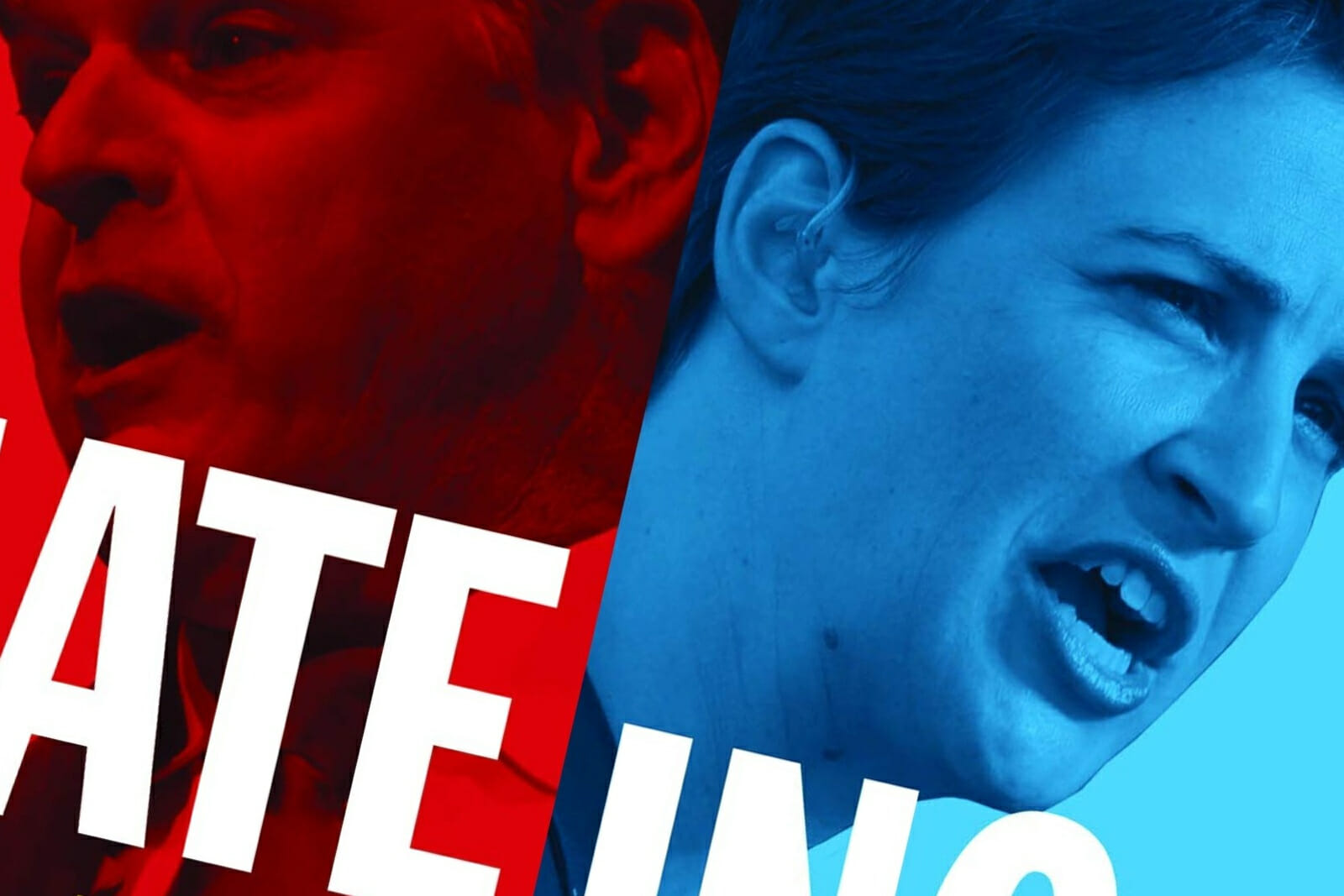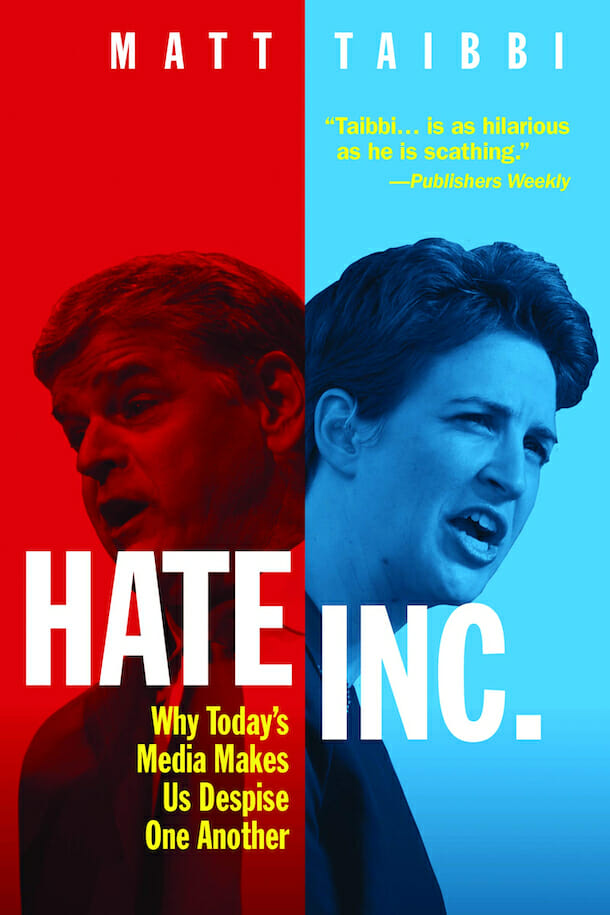
Books
Review: Matt Taibbi’s ‘Hate Inc.’
Following 2016, the media looked like it would be forced to have a period of self-reflection, as many admitted the entertainment value of Trump earned him an unstoppable amount of airtime. People could see it even as it was happening. That self-reflection never came however, and the media’s reaction was more a condemnation of the electorate: racist, stupid, gullible, and so-on. The overall lack of turnout, for both candidates, was treated as largely unimportant.
Hate Inc. seeks to rectify this. Taibbi uses the backdrop of Trump as a screed against major network news. It’s a concise history arguing that Trump was a new set of symptoms for an otherwise familiar disease. The book effectively references the past, present, and future of the news and its relationship to state and corporate power.
Standalone Chapters
Many chapters stand on their own quite well. In Chapter 9, “Scare Tactics,” Taibbi discusses the history of reporting about the Mod clashes in 1960s England. Headlines began circulating about youth gang fights. Taibbi uses the clashes to accentuate the news’ methods for inflating threats. He also draws a line between local and national reporting, arguing that the local papers were much more accurate and less likely to misrepresent details.
“10 Rules of Hate” discusses how the news pits regular people against one another. These include familiar Chomsky-esque arguments such as limiting options of “Republican vs Democrat” and redirecting anger at individuals and not powerful institutions.
“Scarlet Letter Club” is a fantastic run-down of the medias’ falling in line over the Afghanistan and Iraq invasions. Taibbi points out, “ABC, CBS, NBC, and PBS stacked the deck…In a two week period before the invasion, the networks had just one American guest out of 267 who questioned the war.” It also goes into detail about the smaller ways in which the war was pushed, such as having Senator John McCain appear on David Letterman. The context given to the phrase, “reporters are stenographers,” is especially damning. The problem isn’t the repetition of the state’s misdirection but the internalizing of it among reporters.
Maintaining a Center
Many chapters in Hate Inc. deal with the mainstream media’s inability to grapple with policy issues, instead they use social signifiers to help people relate to candidates for reasons beyond their platforms. Taibbi talks about “The Beer Primary” and its origin as a Sam Adams poll done for marketing purposes. Later in the same chapter, Taibbi comments on how often Obama was talked about using sports references: pundits saying things like “he always sinks it at the buzzer.” The news circumvents political issues by building characters out of politicians.
What Should Have Been Cut
Two chapters in particular feel like chaff: “How the News is Like Pro Wrestling” and “How the News Became Sports.” The titles and conceits of each chapter are similar, and while that’s part of their superfluousness, it’s not the end of it.
The “Sports” chapter uses an extended story about a Boston sports radio show (The Toucher and Rich Show) going to a playoff game in Chicago and all the local reporters being stunned that Fred “Toucher” Toettcher (one of the hosts) wasn’t a genuine Patriots fan. This story was funny, well written, and one of the most charming sections of the book—I’m personally quite glad I got to read it—and it absolutely could have been cut. It’s way too long to get to a point about how political news has turned into a defacto cheering section for political factions. This point did not need a whole chapter, and any other points made in the chapter were too insignificant to remember. In addition, the book used sports metaphors throughout. The way reporters use basketball analogies for Obama is discussed on page ninety-nine and, on page ninety-six, Taibbi compares the flack people get from Mark Halperin to Skip Bayless’s comments. So the sports chapter wasn’t even able to monopolize the sports metaphors.

“Wrestling” suffers from a similar issue, much of the chapter is built around the story of one wrestling heel (villain) comparing himself to Donald Trump. There’s also an interesting comment about Kayfabe (wrestlers pretending its real) in politicians and how voters respond to it. But it is at best a complement to the character-building discussed in other chapters. The chapter then gets caught up in a story where Trump said Obama “schlonged” Hillary Clinton. It is part of Taibbi’s point about the “media heel” problem, but surely Trump’s public quibble with John McCain’s legacy as a POW would have been a more memorable example.
Unlearned Lessons
It seems the media is unlikely to improve themselves going into 2020. In response to Trump’s victory, many major publications have adopted anti-Trump right-wingers to their opinion pages such as David Brooks and Brett Stephens. During the 2018 midterm and 2020 primary, however, David Brooks asked the Democrats “Will there be a candidate I can vote for?” if someone too far to the Left is nominated. This is to be expected, but it shows the bigger danger of Trump’s success that people ignore.
In an attempt to stop Trump at all costs, writers and news outlets have begun to side with or help clean the histories of far-right individuals. The most recent example being on people calling for John Bolton to testify at the Trump impeachment. This means that not only can dangerous actors like Bolton get a second wind, but it’s also likely they will be welcomed back into politics with open arms. Meanwhile, many of Trump’s interventionist projects, such as suppressing the power of China, Iran, and Venezuela, failed. His attempts to empower Israel are receiving uncharacteristic, mainstream pushback as well.
Given the media’s inability to really criticize itself as shown above and as detailed in Taibbi’s book, I fear that a Trump loss in 2020 will open the door for all these dangerous policy positions to be destigmatized. Early presidential frontrunner Joe Biden has already stated that he thinks the Republicans can be worked with once Trump is gone. I imagine that we will see Trump-Interventionist vs Responsible-Interventionist being a major distinction drawn in the near future.
This also plays into Taibbi’s comments on Russiagate being “the new WMD.” The initial issue surrounding Russiagate was how it allowed Democrats to paint their detractors with a broad brush. People would publish lists of “Russia influenced media” and it would conflate genuine fake outlets with longstanding alternative media outlets such as Naked Capital.
Recently an article referred to Sputnik News as “Kremlin Propaganda” being pushed on DC, because it is state-owned news. It would be like referring to the BBC as “British Propaganda” or any major American news as “Bourgeois Propaganda.” Even if one can make that argument, the scary part is that right now politicians and journalists don’t have to make the argument. It is assumed to be true.

